Abstract
Familial persistent hyperinsulinemic hypoglycemia of infancy (PHHI) is a rare, autosomal recessive disease of unregulated insulin secretion, defined by elevations in serum insulin despite severe hypoglycemia. We used the homozygosity gene-mapping strategy to localize this disorder to the region of chromosome 11p between markers D11S1334 and D11S899 (maximum LOD score 5.02 [theta = 0] at marker D11S926) in five consanguineous families of Saudi Arabian origin. These results extend those of a recent report that also placed PHHI on chromosome 11p, between markers D11S926 and D11S928. Comparison of the boundaries of these two overlapping regions allows the PHHI locus to be assigned to the 4-cM region between the markers D11S926 and D11S899. Identification of this gene may allow a better understanding of other disorders of glucose homeostasis, by providing insight into the regulation of insulin release.
Full text
PDF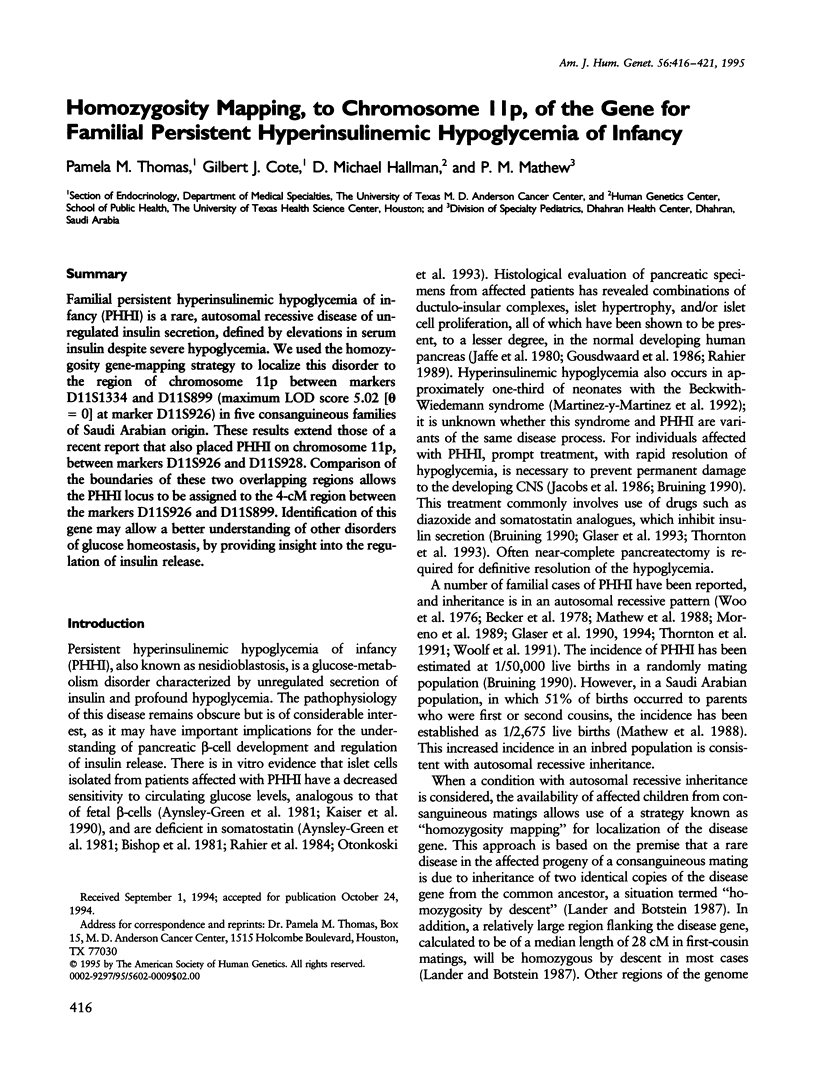
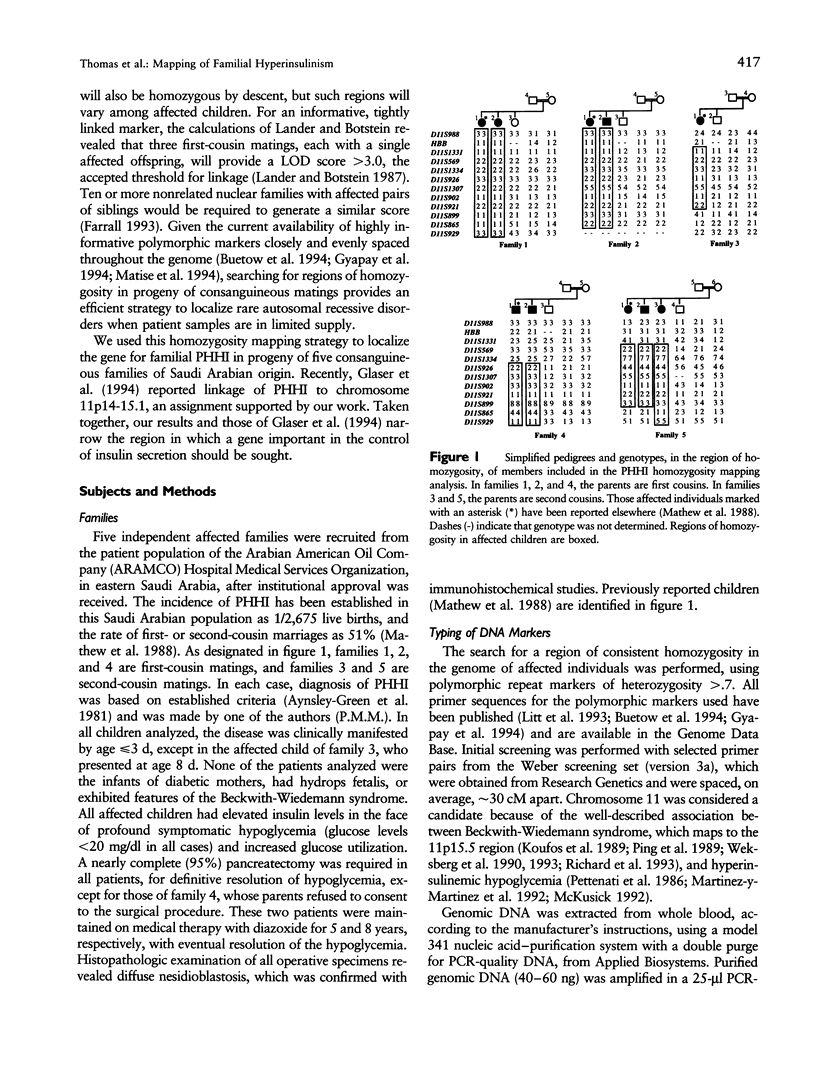
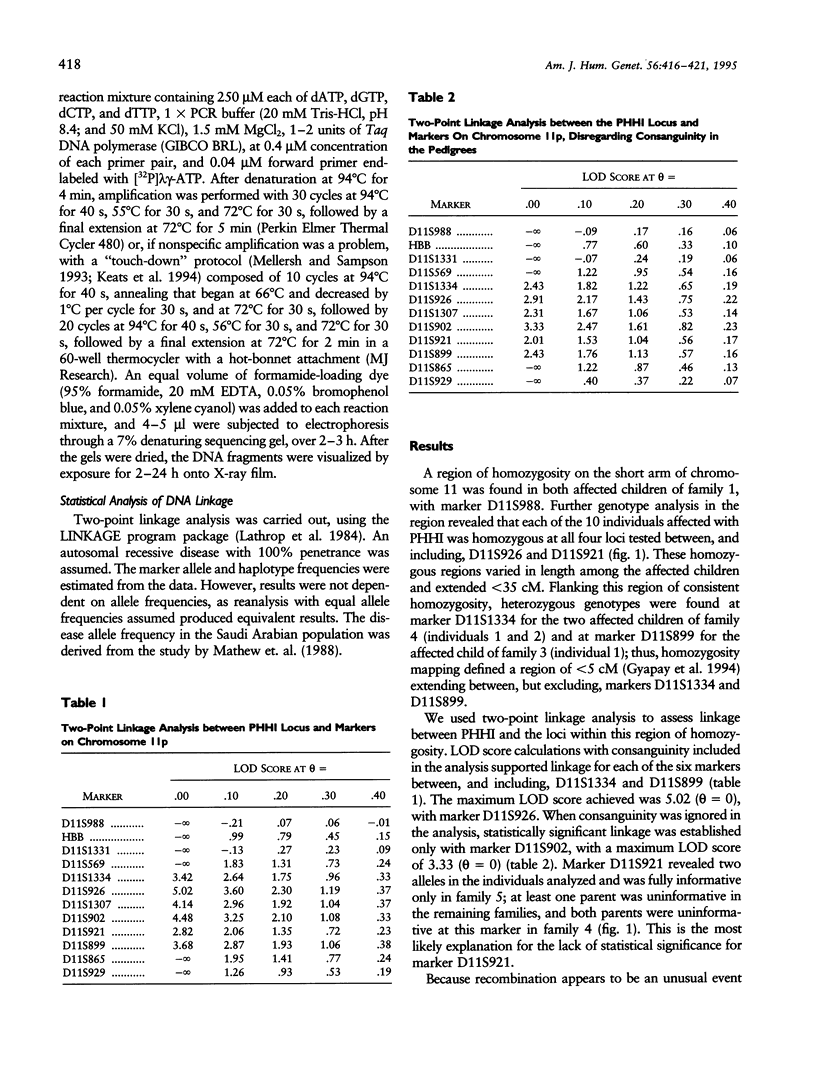
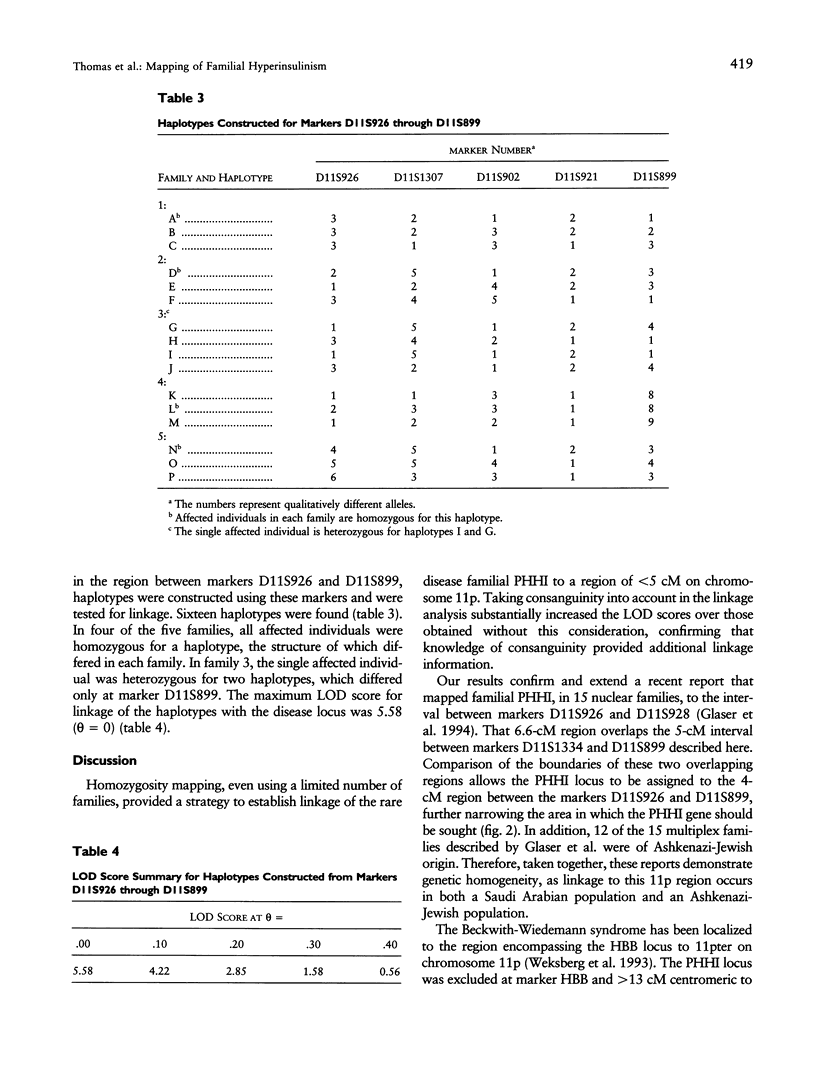
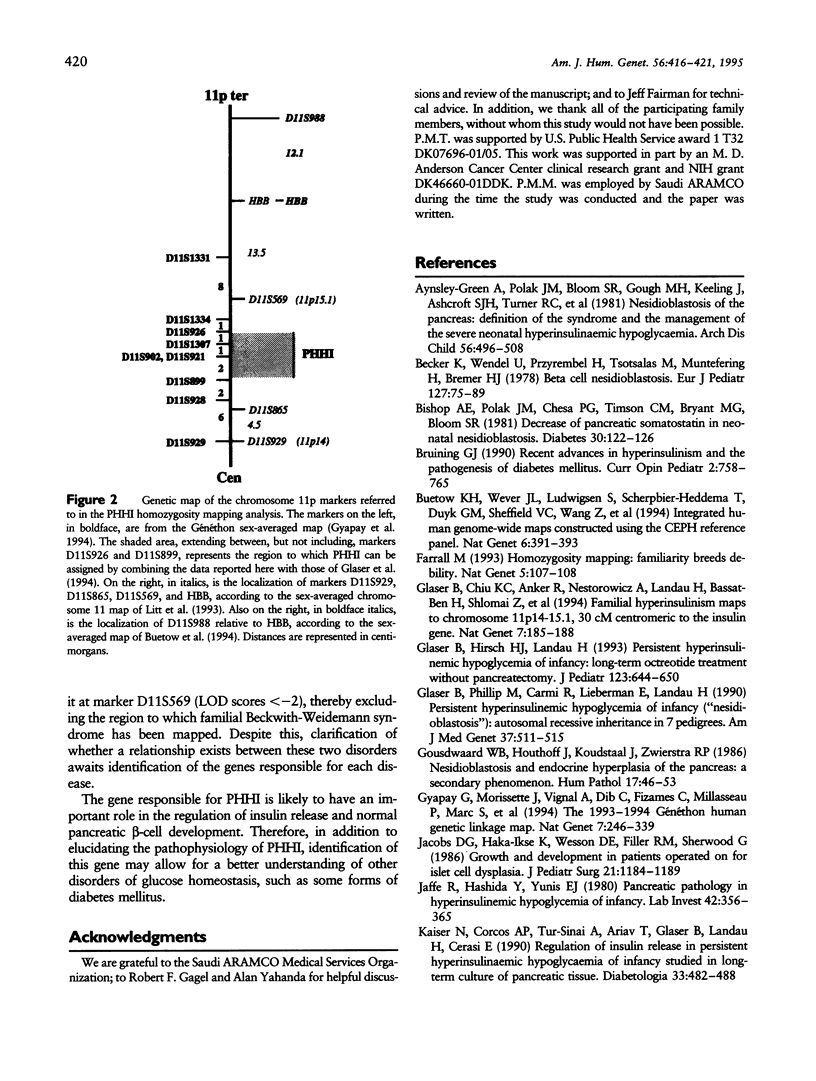
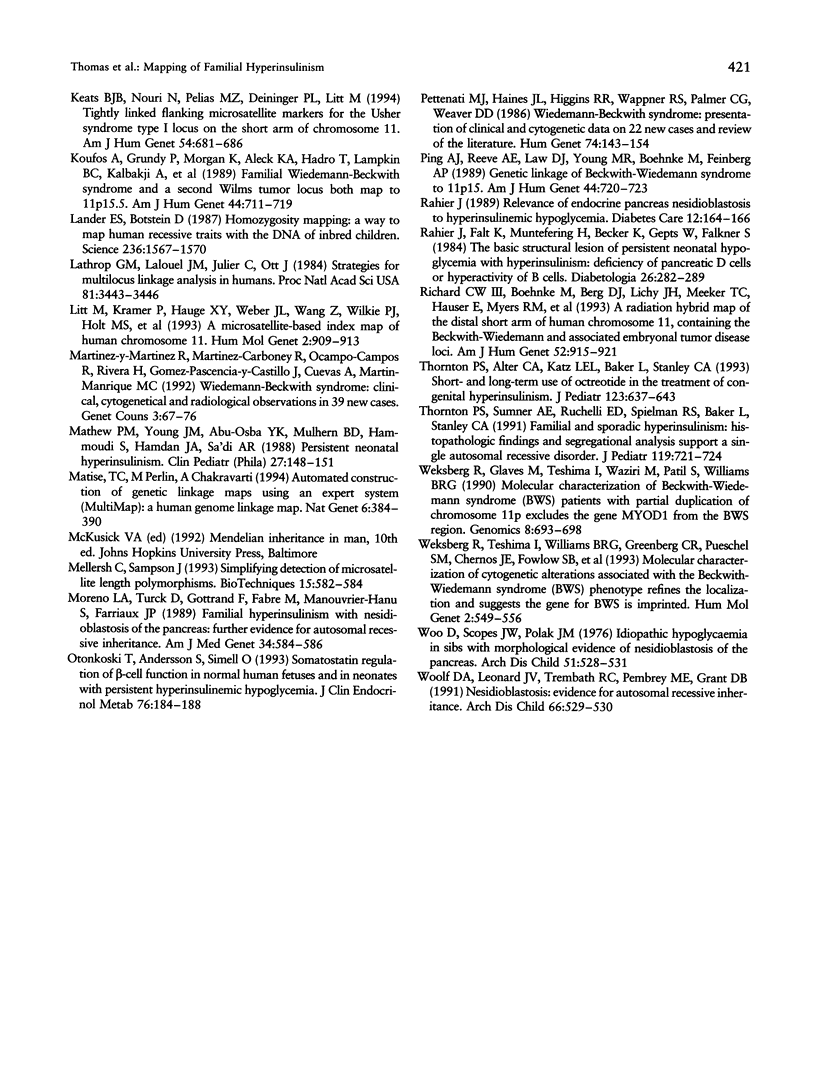
Selected References
These references are in PubMed. This may not be the complete list of references from this article.
- Aynsley-Green A., Polak J. M., Bloom S. R., Gough M. H., Keeling J., Ashcroft S. J., Turner R. C., Baum J. D. Nesidioblastosis of the pancreas: definition of the syndrome and the management of the severe neonatal hyperinsulinaemic hypoglycaemia. Arch Dis Child. 1981 Jul;56(7):496–508. doi: 10.1136/adc.56.7.496. [DOI] [PMC free article] [PubMed] [Google Scholar]
- Becker K., Wendel U., Przyrembel H., Tsotsalas M., Münterfering H., Bremer H. J. Beta cell nesidioblastosis. Eur J Pediatr. 1978 Jan 17;127(2):75–89. doi: 10.1007/BF00445763. [DOI] [PubMed] [Google Scholar]
- Bishop A. E., Polak J. M., Chesa P. G., Timson C. M., Bryant M. G., Bloom S. R. Decrease of pancreatic somatostatin in neonatal nesidioblastosis. Diabetes. 1981 Feb;30(2):122–126. doi: 10.2337/diab.30.2.122. [DOI] [PubMed] [Google Scholar]
- Buetow K. H., Weber J. L., Ludwigsen S., Scherpbier-Heddema T., Duyk G. M., Sheffield V. C., Wang Z., Murray J. C. Integrated human genome-wide maps constructed using the CEPH reference panel. Nat Genet. 1994 Apr;6(4):391–393. doi: 10.1038/ng0494-391. [DOI] [PubMed] [Google Scholar]
- Farrall M. Homozygosity mapping: familiarity breeds debility. Nat Genet. 1993 Oct;5(2):107–108. doi: 10.1038/ng1093-107. [DOI] [PubMed] [Google Scholar]
- Glaser B., Chiu K. C., Anker R., Nestorowicz A., Landau H., Ben-Bassat H., Shlomai Z., Kaiser N., Thornton P. S., Stanley C. A. Familial hyperinsulinism maps to chromosome 11p14-15.1, 30 cM centromeric to the insulin gene. Nat Genet. 1994 Jun;7(2):185–188. doi: 10.1038/ng0694-185. [DOI] [PubMed] [Google Scholar]
- Glaser B., Hirsch H. J., Landau H. Persistent hyperinsulinemic hypoglycemia of infancy: long-term octreotide treatment without pancreatectomy. J Pediatr. 1993 Oct;123(4):644–650. doi: 10.1016/s0022-3476(05)80970-9. [DOI] [PubMed] [Google Scholar]
- Glaser B., Phillip M., Carmi R., Lieberman E., Landau H. Persistent hyperinsulinemic hypoglycemia of infancy ("nesidioblastosis"): autosomal recessive inheritance in 7 pedigrees. Am J Med Genet. 1990 Dec;37(4):511–515. doi: 10.1002/ajmg.1320370416. [DOI] [PubMed] [Google Scholar]
- Goudswaard W. B., Houthoff H. J., Koudstaal J., Zwierstra R. P. Nesidioblastosis and endocrine hyperplasia of the pancreas: a secondary phenomenon. Hum Pathol. 1986 Jan;17(1):46–54. doi: 10.1016/s0046-8177(86)80154-x. [DOI] [PubMed] [Google Scholar]
- Gyapay G., Morissette J., Vignal A., Dib C., Fizames C., Millasseau P., Marc S., Bernardi G., Lathrop M., Weissenbach J. The 1993-94 Généthon human genetic linkage map. Nat Genet. 1994 Jun;7(2 Spec No):246–339. doi: 10.1038/ng0694supp-246. [DOI] [PubMed] [Google Scholar]
- Jacobs D. G., Haka-Ikse K., Wesson D. E., Filler R. M., Sherwood G. Growth and development in patients operated on for islet cell dysplasia. J Pediatr Surg. 1986 Dec;21(12):1184–1189. doi: 10.1016/0022-3468(86)90035-7. [DOI] [PubMed] [Google Scholar]
- Jaffe R., Hashida Y., Yunis E. J. Pancreatic pathology in hyperinsulinemic hypoglycemia of infancy. Lab Invest. 1980 Mar;42(3):356–365. [PubMed] [Google Scholar]
- Kaiser N., Corcos A. P., Tur-Sinai A., Ariav Y., Glaser B., Landau H., Cerasi E. Regulation of insulin release in persistent hyperinsulinaemic hypoglycaemia of infancy studied in long-term culture of pancreatic tissue. Diabetologia. 1990 Aug;33(8):482–488. doi: 10.1007/BF00405110. [DOI] [PubMed] [Google Scholar]
- Keats B. J., Nouri N., Pelias M. Z., Deininger P. L., Litt M. Tightly linked flanking microsatellite markers for the Usher syndrome type I locus on the short arm of chromosome 11. Am J Hum Genet. 1994 Apr;54(4):681–686. [PMC free article] [PubMed] [Google Scholar]
- Koufos A., Grundy P., Morgan K., Aleck K. A., Hadro T., Lampkin B. C., Kalbakji A., Cavenee W. K. Familial Wiedemann-Beckwith syndrome and a second Wilms tumor locus both map to 11p15.5. Am J Hum Genet. 1989 May;44(5):711–719. [PMC free article] [PubMed] [Google Scholar]
- Lander E. S., Botstein D. Homozygosity mapping: a way to map human recessive traits with the DNA of inbred children. Science. 1987 Jun 19;236(4808):1567–1570. doi: 10.1126/science.2884728. [DOI] [PubMed] [Google Scholar]
- Lathrop G. M., Lalouel J. M., Julier C., Ott J. Strategies for multilocus linkage analysis in humans. Proc Natl Acad Sci U S A. 1984 Jun;81(11):3443–3446. doi: 10.1073/pnas.81.11.3443. [DOI] [PMC free article] [PubMed] [Google Scholar]
- Litt M., Kramer P., Hauge X. Y., Weber J. L., Wang Z., Wilkie P. J., Holt M. S., Mishra S., Donis-Keller H., Warnich L. A microsatellite-based index map of human chromosome 11. Hum Mol Genet. 1993 Jul;2(7):909–913. doi: 10.1093/hmg/2.7.909. [DOI] [PubMed] [Google Scholar]
- Martínez y Martínez R., Martínez-Carboney R., Ocampo-Campos R., Rivera H., Gómez Plascencia y Castillo J., Cuevas A., Martín Manrique M. C. Wiedemann-Beckwith syndrome: clinical, cytogenetical and radiological observations in 39 new cases. Genet Couns. 1992;3(2):67–76. [PubMed] [Google Scholar]
- Mathew P. M., Young J. M., Abu-Osba Y. K., Mulhern B. D., Hammoudi S., Hamdan J. A., Sa'di A. R. Persistent neonatal hyperinsulinism. Clin Pediatr (Phila) 1988 Mar;27(3):148–151. doi: 10.1177/000992288802700307. [DOI] [PubMed] [Google Scholar]
- Matise T. C., Perlin M., Chakravarti A. Automated construction of genetic linkage maps using an expert system (MultiMap): a human genome linkage map. Nat Genet. 1994 Apr;6(4):384–390. doi: 10.1038/ng0494-384. [DOI] [PubMed] [Google Scholar]
- Mellersh C., Sampson J. Simplifying detection of microsatellite length polymorphisms. Biotechniques. 1993 Oct;15(4):582–584. [PubMed] [Google Scholar]
- Moreno L. A., Turck D., Gottrand F., Fabre M., Manouvrier-Hanu S., Farriaux J. P. Familial hyperinsulinism with nesidioblastosis of the pancreas: further evidence for autosomal recessive inheritance. Am J Med Genet. 1989 Dec;34(4):584–586. doi: 10.1002/ajmg.1320340426. [DOI] [PubMed] [Google Scholar]
- Otonkoski T., Andersson S., Simell O. Somatostatin regulation of beta-cell function in the normal human fetuses and in neonates with persistent hyperinsulinemic hypoglycemia. J Clin Endocrinol Metab. 1993 Jan;76(1):184–188. doi: 10.1210/jcem.76.1.8093619. [DOI] [PubMed] [Google Scholar]
- Pettenati M. J., Haines J. L., Higgins R. R., Wappner R. S., Palmer C. G., Weaver D. D. Wiedemann-Beckwith syndrome: presentation of clinical and cytogenetic data on 22 new cases and review of the literature. Hum Genet. 1986 Oct;74(2):143–154. doi: 10.1007/BF00282078. [DOI] [PubMed] [Google Scholar]
- Ping A. J., Reeve A. E., Law D. J., Young M. R., Boehnke M., Feinberg A. P. Genetic linkage of Beckwith-Wiedemann syndrome to 11p15. Am J Hum Genet. 1989 May;44(5):720–723. [PMC free article] [PubMed] [Google Scholar]
- Rahier J., Fält K., Müntefering H., Becker K., Gepts W., Falkmer S. The basic structural lesion of persistent neonatal hypoglycaemia with hyperinsulinism: deficiency of pancreatic D cells or hyperactivity of B cells? Diabetologia. 1984 Apr;26(4):282–289. doi: 10.1007/BF00283651. [DOI] [PubMed] [Google Scholar]
- Rahier J. Relevance of endocrine pancreas nesidioblastosis to hyperinsulinemic hypoglycemia. Diabetes Care. 1989 Feb;12(2):164–166. doi: 10.2337/diacare.12.2.164. [DOI] [PubMed] [Google Scholar]
- Richard C. W., 3rd, Boehnke M., Berg D. J., Lichy J. H., Meeker T. C., Hauser E., Myers R. M., Cox D. R. A radiation hybrid map of the distal short arm of human chromosome 11, containing the Beckwith-Wiedemann and associated embryonal tumor disease loci. Am J Hum Genet. 1993 May;52(5):915–921. [PMC free article] [PubMed] [Google Scholar]
- Thornton P. S., Alter C. A., Katz L. E., Baker L., Stanley C. A. Short- and long-term use of octreotide in the treatment of congenital hyperinsulinism. J Pediatr. 1993 Oct;123(4):637–643. doi: 10.1016/s0022-3476(05)80969-2. [DOI] [PubMed] [Google Scholar]
- Thornton P. S., Sumner A. E., Ruchelli E. D., Spielman R. S., Baker L., Stanley C. A. Familial and sporadic hyperinsulinism: histopathologic findings and segregation analysis support a single autosomal recessive disorder. J Pediatr. 1991 Nov;119(5):721–724. doi: 10.1016/s0022-3476(05)80286-0. [DOI] [PubMed] [Google Scholar]
- Weksberg R., Glaves M., Teshima I., Waziri M., Patil S., Williams B. R. Molecular characterization of Beckwith-Wiedemann syndrome (BWS) patients with partial duplication of chromosome 11p excludes the gene MYOD1 from the BWS region. Genomics. 1990 Dec;8(4):693–698. doi: 10.1016/0888-7543(90)90256-t. [DOI] [PubMed] [Google Scholar]
- Weksberg R., Teshima I., Williams B. R., Greenberg C. R., Pueschel S. M., Chernos J. E., Fowlow S. B., Hoyme E., Anderson I. J., Whiteman D. A. Molecular characterization of cytogenetic alterations associated with the Beckwith-Wiedemann syndrome (BWS) phenotype refines the localization and suggests the gene for BWS is imprinted. Hum Mol Genet. 1993 May;2(5):549–556. doi: 10.1093/hmg/2.5.549. [DOI] [PubMed] [Google Scholar]
- Woo D., Scopes J. W., Polak J. M. Idiopathic hypoglycaemia in sibs with morphological evidence of nesidioblastosis of the pancreas. Arch Dis Child. 1976 Jul;51(7):528–531. doi: 10.1136/adc.51.7.528. [DOI] [PMC free article] [PubMed] [Google Scholar]
- Woolf D. A., Leonard J. V., Trembath R. C., Pembrey M. E., Grant D. B. Nesidioblastosis: evidence for autosomal recessive inheritance. Arch Dis Child. 1991 Apr;66(4):529–530. doi: 10.1136/adc.66.4.529. [DOI] [PMC free article] [PubMed] [Google Scholar]


